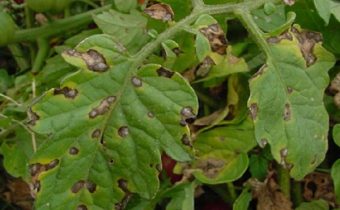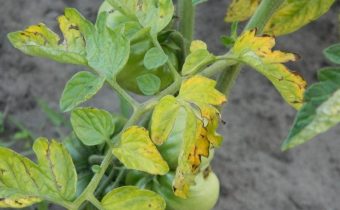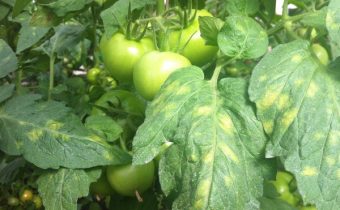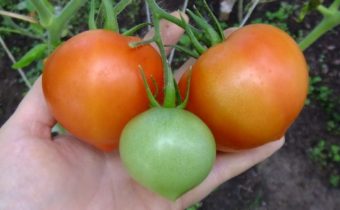Tomato seedlings on the inner side of leaves have white spots
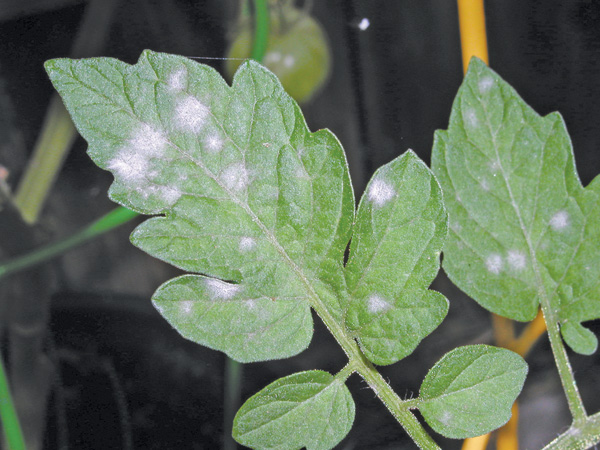
The appearance of white spots on the leaves of tomatoes has several causes, but is never a harmless phenomenon. In all cases, the symptom indicates a serious threat to the health of plants. When a problem is detected, it is necessary to immediately isolate the diseased bush and inspect others - most often white spots appear as a result of the activity of disease-causing fungi. But the reason may also be violations in the care and incorrect conditions of detention.
The reasons
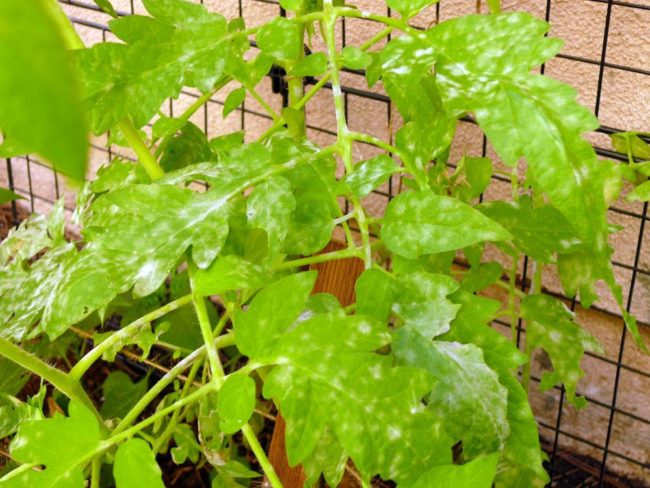 White spots on seedlings can appear for three reasons:
White spots on seedlings can appear for three reasons:
- sunburn;
- fungal disease;
- imbalance of iron or manganese.
It is easy to determine the origin of the spotting - all three types of spots differ in appearance. So, burn marks usually appear in the upper part of the bush, the tissues in the damaged area look dried. Spots of fungus affect primarily the lower leaves and are often covered with velvety bloom. When the imbalance of nutrients is disturbed, only the leaf plate between the veins changes color.
Sunburn
If seedlings without pre-hardening will spend several hours under direct sunlight, the plant can be seriously damaged. You can avoid unpleasant consequences if you gradually accustom the seedlings to the sun. The first time the tomatoes need to take out to the fresh air for 10 minutes, with each next day, the time of the procedure should be extended for several minutes.
Even a seasoned adult plant, caught in the sun after watering or spraying, will get burned. Drops of water on the leaves and stems act as lenses - focusing the rays and increasing the strength of their effects.
Burns look almost transparent and can be of a different size, depending on the degree of damage. Sometimes the whole leaf may turn white.
Lack of trace elements
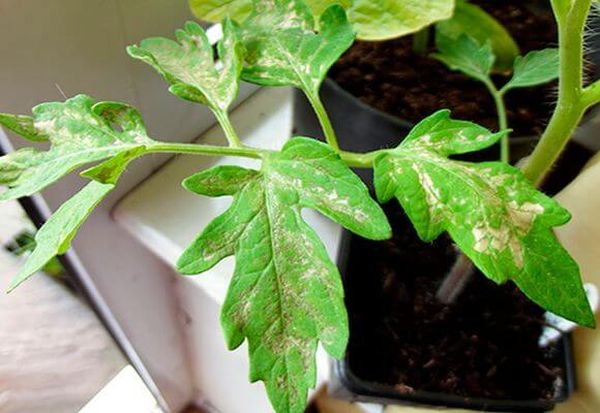 Pale spots may be a symptom of iron deficiency or an excess of manganese in tomato seedlings. In both cases, white spots appear on the lower leaves. If there is a shortage of iron, some leaves on the bush will be colored between the veins in yellow. Manganese poisoning is manifested by brown specks on all levels of the bush and deformation of the leaves of the upper tier.
Pale spots may be a symptom of iron deficiency or an excess of manganese in tomato seedlings. In both cases, white spots appear on the lower leaves. If there is a shortage of iron, some leaves on the bush will be colored between the veins in yellow. Manganese poisoning is manifested by brown specks on all levels of the bush and deformation of the leaves of the upper tier.
The cause of iron deficiency in seedlings may be excessive levels of calcium in the substrate. In addition, iron is not absorbed, if the seedlings do not turn off the lights, even at night. For normal development, tomato seedlings require a light day lasting 10-12 hours, but no more.
Fungal diseases
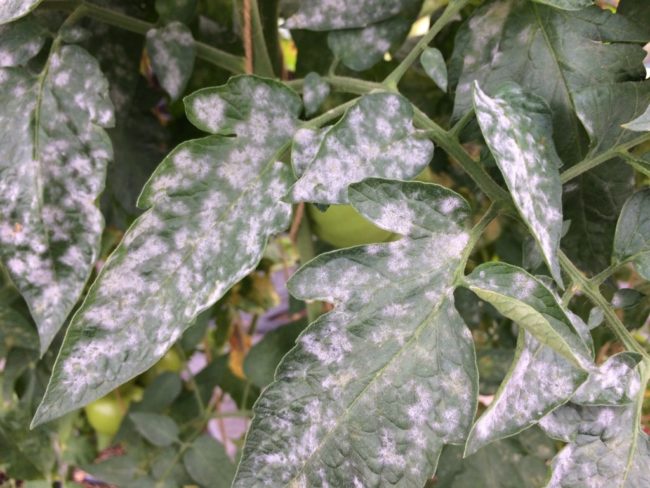 There are several diseases that cause the leaves of the seedlings to turn white. Some diseases can affect adult bushes, especially those growing in the greenhouse. Fungi cause them.
There are several diseases that cause the leaves of the seedlings to turn white. Some diseases can affect adult bushes, especially those growing in the greenhouse. Fungi cause them.
Diseases in which the leaves turn white:
- Mealy dew. White spots covered with fluffy "moss" appear on the back side of the sheet, and from the outside in the appropriate places are areas of gray patina. Spreading up the bush, a colony of the fungus captures the entire plant, causing it to dry. The appearance of the fungus is favored by too high air humidity and temperature in the room with seedlings, as well as excessive watering.
- CladosporiosisOn closer examination, whitish bloom has a light yellow tint, over time it changes color to brown. Velvety brown spots appear on the reverse side of the leaf. In the advanced stage, the leaves curl, dry and fall. The emergence of the disease contributes to the lack of light and high humidity. Hybrid varieties of tomatoes are more susceptible to fungi.
- Septoria. White spots appear on the leaves, expanding up to half a centimeter in diameter. The edge of the spot is bordered by a gray ring, and a dot of the same shade forms in the center. As the disease develops, spots also appear on the stem. Septoria often occurs on plants suffering from excessive watering and heat.
- Mosaic rot. In this disease, white areas appear on the back of the leaves, their upper part is covered with yellow spots. Activation of the fungus contribute to violations of the temperature regime.
- White rot. Velvety, whitish bloom first appears on the stem. The affected areas begin to rot, secreting mucus, as a result of which the plant dies. It occurs with high humidity and cool temperatures.
At the onset of the disease, late blight and brown spotting are also manifested by white bloom on the leaves. With late blight white spots dry out, and with brown spot their color changes to brown rather quickly.
Treatment measures
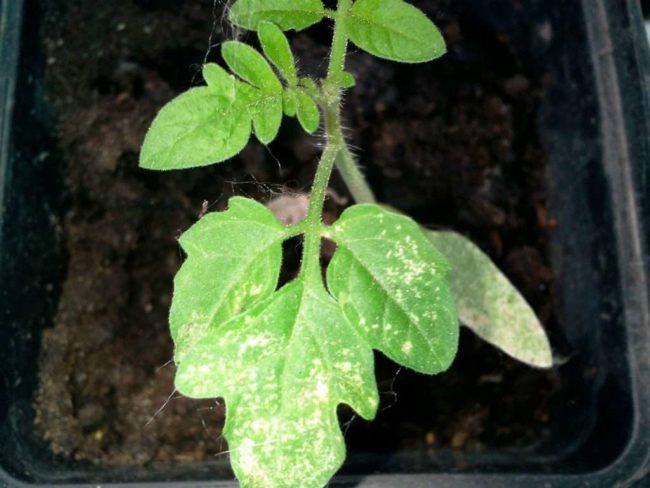 If the plant has suffered from the sun, it is recommended to spray it with a growth stimulator, for example, Epin, which should be done in the evening. Tomatoes can recover even after a large lesion, but the bush will hardly grow well - damaged leaves lose their photosynthesis ability. It is impossible to cure completely burnt leaves, so they should be removed.
If the plant has suffered from the sun, it is recommended to spray it with a growth stimulator, for example, Epin, which should be done in the evening. Tomatoes can recover even after a large lesion, but the bush will hardly grow well - damaged leaves lose their photosynthesis ability. It is impossible to cure completely burnt leaves, so they should be removed.
Iron deficiency can be eliminated by spraying the bushes with a 0.1% solution of Ferrovit. If manganese poisoning is necessary to transplant seedlings in a fresh substrate.
Treatment of fungal diseases:
- Leaves affected by the powdery mildew should be cut off, and the bush should be sprayed with Trichodermine, Gaupsin or Fundazole. Proponents of popular recipes recommend treatment with whey, but the agent acts only in the early stages of the disease, you can use it to prevent disease in neighboring plants. Rassad will be useful fertilizing with phosphorus and potassium, whereas it is definitely not worth making nitrogen under the plants.
- With clasporiosis First, you need to remove the damaged areas, then treat the seedlings with copper-containing products. With a small lesion, you can start with "Fitosporina" or "Pseudobacterin", repeating treatment after 3 weeks, but if the disease returns, you need to use a more powerful tool. Spraying is repeated when new symptoms of the disease appear.
- Seedlings affected by septoria should be sprayed with Bordeaux liquid, after removing the diseased parts of the plants. In case of failure, you should take advantage of a stronger fungicide, for example, "Title" or "Thanos." If the lesion is in an advanced stage, it remains to get rid of the bush that spreads the infection.
- Mosaic Rot Treatment rarely gives positive results, so it is worth destroying infected plants as soon as a diagnosis is made.
- Seedlings that become ill with white rot can be resuscitated by spraying with solutions of copper sulfate or potassium permanganate. But the prognosis for healing plants for this disease is not very optimistic.
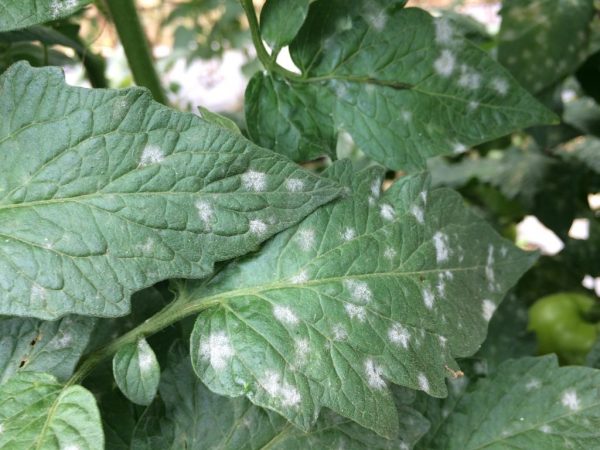
Reliable prevention of the occurrence of white spots on the leaves of seedlings is the observance of all the rules of agricultural cultivation.Improper care can not only become a source of the problem, as in the case of over-feeding and supplementing or placing hardened seedlings in the sun, but also contribute to the appearance of fungal diseases. Activation of fungal spores almost always provokes high humidity, a violation of the temperature regime and low plant immunity.


